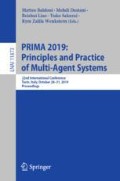Abstract
Simultaneous environment coverage represents a challenging multi-agent application, in which mobile agents (drones) must cover surfaces by simultaneously capturing images from different viewpoints. It constitutes a complex optimization problem with potentially conflicting criteria, such as mission time and coverage quality, and requires dynamic coordination of agent tasks. In this paper, we introduce a decentralized coordination method, adaptive to a dynamic and a priori unknown 3D environment. Our approach selects the role an agent should take on and coordinates the assignment of agents to their computed viewpoints. Our main goal is to cover all detected objects in the environment at a certain quality as soon as possible. We evaluate the methods in AirSim in different setups and assess how the proposed methods respond to dynamic changes in the environment.
Access this chapter
Tax calculation will be finalised at checkout
Purchases are for personal use only
References
Badreldin, M., Hussein, A., Khamis, A.: A comparative study between optimization and market-based approaches to multi-robot task allocation. Adv. Artif. Intell. 2013, 12 (2013). https://doi.org/10.1155/2013/256524
Berman, S., Halász, Á., Hsieh, M.A., Kumar, V.: Optimized stochastic policies for task allocation in swarms of robots. IEEE Trans. Robot. 25(4), 927–937 (2009). https://doi.org/10.1109/TRO.2009.2024997
Bircher, A., Kamel, M., Alexis, K., Oleynikova, H., Siegwart, R.: Receding horizon “next-best-view” planner for 3D exploration. In: Proceedings of IEEE International Conference on Robotics and Automation, pp. 1462–1468. IEEE (2016). https://doi.org/10.1109/ICRA.2016.7487281
Bircher, A., Kamel, M., Alexis, K., Oleynikova, H., Siegwart, R.: Receding horizon path planning for 3D exploration and surface inspection. Auton. Robot. 42(2), 291–306 (2018). https://doi.org/10.1007/s10514-016-9610-0
Capitan, J., Spaan, M.T., Merino, L., Ollero, A.: Decentralized multi-robot cooperation with auctioned POMDPs. Int. J. Robot. Res. 32(6), 650–671 (2013). https://doi.org/10.1109/ICRA.2012.6224917
Chang, C., Chatterjee, S.: Quantization error analysis in stereo vision. In: Proceedings of Asilomar Conference on Signals, Systems & Computers, pp. 1037–1041. IEEE (1992). https://doi.org/10.1109/ACSSC.1992.269140
Deb, K., Pratap, A., Agarwal, S., Meyarivan, T.: A fast and elitist multiobjective genetic algorithm: NSGA-II. IEEE Trans. Evol. Comput. 6(2), 182–197 (2002). https://doi.org/10.1109/4235.996017
Fonooni, B., Jevtić, A., Hellström, T., Janlert, L.E.: Applying ant colony optimization algorithms for high-level behavior learning and reproduction from demonstrations. Robot. Auton. Syst. 65, 24–39 (2015). https://doi.org/10.1016/j.robot.2014.12.001
Freundlich, C., Zhang, Y., Zhu, A.Z., Mordohai, P., Zavlanos, M.M.: Controlling a robotic stereo camera under image quantization noise. Int. J. Robot. Res. 36(12), 1268–1285 (2017). https://doi.org/10.1177/0278364917735163
Galceran, E., Carreras, M.: A survey on coverage path planning for robotics. Robot. Auton. Syst. 61(12), 1258–1276 (2013). https://doi.org/10.1016/j.robot.2013.09.004
Gallup, D., Frahm, J.M., Mordohai, P., Pollefeys, M.: Variable baseline/resolution stereo. In: Proceedings of IEEE Conference on Computer Vision and Pattern Recognition, pp. 1–8. IEEE (2008). https://doi.org/10.1109/CVPR.2008.4587671
Gerkey, B.P., Mataric, M.J.: Sold!: auction methods for multirobot coordination. IEEE Trans. Robot. Autom. 18(5), 758–768 (2002)
Heng, L., Gotovos, A., Krause, A., Pollefeys, M.: Efficient visual exploration and coverage with a micro aerial vehicle in unknown environments. In: Proceedings of IEEE International Conference on Robotics and Automation, pp. 1071–1078. IEEE (2015). https://doi.org/10.1109/ICRA.2015.7139309
Jiang, A.X., Procaccia, A.D., Qian, Y., Shah, N., Tambe, M.: Defender (mis)coordination in security games. In: Twenty-Third International Joint Conference on Artificial Intelligence (2013)
Khan, A., Rinner, B., Cavallaro, A.: Cooperative robots to observe moving targets: a review. IEEE Trans. Cybern. 48(1), 187–198 (2018). https://doi.org/10.1109/TCYB.2016.2628161
Mazdin, P., Rinner, B.: Efficient and QoS-aware drone coordination for simultaneous environment coverage. In: Proc. IEEE Conference on Multimedia Information Processing and Retrieval, pp. 333–338. IEEE (2019). https://doi.org/10.1109/MIPR.2019.00066
McIntire, M., Nunes, E., Gini, M.: Iterated multi-robot auctions for precedence-constrained task scheduling. In: Proceedings of International Conference on Autonomous Agents & Multiagent Systems, pp. 1078–1086. International Foundation for Autonomous Agents and Multiagent Systems (2016)
Morel, J.M., Yu, G.: ASIFT: a new framework for fully affine invariant image comparison. SIAM J. Imaging Sci. 2(2), 438–469 (2009). https://doi.org/10.1137/080732730
Nakabo, Y., Mukai, T., Hattori, Y., Takeuchi, Y., Ohnishi, N.: Variable baseline stereo tracking vision system using high-speed linear slider. In: Proceedings of IEEE International Conference on Robotics and Automation, pp. 1567–1572. IEEE (2005). https://doi.org/10.1109/ROBOT.2005.1570337
Nunes, E., Gini, M.: Multi-robot auctions for allocation of tasks with temporal constraints. In: Proceedings of AAAI Conference on Artificial Intelligence (2015)
Perez-Carabaza, S., Scherer, J., Rinner, B., Lopez-Orozco, J.A., Besada-Portas, E.: UAV trajectory optimization for minimum time search with communication constraints and collision avoidance. Eng. Appl. Artif. Intell. 85, 357–371 (2019)
Shah, S., Dey, D., Lovett, C., Kapoor, A.: AirSim: high-fidelity visual and physical simulation for autonomous vehicles. In: Proceedings of Field and Service Robotics (2017)
Tambe, M.: Security and Game Theory: Algorithms, Deployed Systems, Lessons Learned. Cambridge University Press (2011). https://doi.org/10.1017/CBO9780511973031
Weyrer, M., Rinner, B.: UAV motion planning and control for multi-coverage of 3D environments. In: Proceedings of International Conference on Unmanned Aircraft Systems, pp. 939–946 (2018). https://doi.org/10.1109/ICUAS.2018.8453427
Yanmaz, E., Yahyanejad, S., Rinner, B., Hellwagner, H., Bettstetter, C.: Drone networks: communications, coordination, and sensing. Ad Hoc Networks 68(1), 1–15 (2018). https://doi.org/10.1016/j.adhoc.2017.09.001
Yoder, L., Scherer, S.: Autonomous exploration for infrastructure modeling with a micro aerial vehicle. In: Wettergreen, D.S., Barfoot, T.D. (eds.) Field and Service Robotics. STAR, vol. 113, pp. 427–440. Springer, Cham (2016). https://doi.org/10.1007/978-3-319-27702-8_28
Zhang, C., Lesser, V.: Coordinated multi-agent reinforcement learning in networked distributed POMDPs. In: Proceedings of AAAI Conference on Artificial Intelligence (2011)
Acknowledgments
This work is supported by the Karl Popper Kolleg on Networked Autonomous Aerial Vehicles (uav.aau.at) at the University of Klagenfurt.
Author information
Authors and Affiliations
Corresponding authors
Editor information
Editors and Affiliations
Rights and permissions
Copyright information
© 2019 Springer Nature Switzerland AG
About this paper
Cite this paper
Mazdin, P., Rinner, B. (2019). Coordination of Mobile Agents for Simultaneous Coverage. In: Baldoni, M., Dastani, M., Liao, B., Sakurai, Y., Zalila Wenkstern, R. (eds) PRIMA 2019: Principles and Practice of Multi-Agent Systems. PRIMA 2019. Lecture Notes in Computer Science(), vol 11873. Springer, Cham. https://doi.org/10.1007/978-3-030-33792-6_11
Download citation
DOI: https://doi.org/10.1007/978-3-030-33792-6_11
Published:
Publisher Name: Springer, Cham
Print ISBN: 978-3-030-33791-9
Online ISBN: 978-3-030-33792-6
eBook Packages: Computer ScienceComputer Science (R0)

